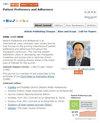Living with and Caring for People with Multiple Food Allergies: A Qualitative Study
IF 2
3区 医学
Q2 MEDICINE, GENERAL & INTERNAL
引用次数: 0
Abstract
Purpose: The quality of life (QoL) impact of food allergies extends beyond severe allergic reactions, as food avoidance can permeate the daily lives of individuals with food allergies and their caregivers. People with multiple food allergies may experience a greater impact on QoL than people with a single food allergy, but there is limited evidence available. The aim of the study was to provide insight into the lived experiences of adults, teenagers, children, and caregivers of children with multiple food allergies.Methods: Semi-structured interviews were conducted of people with multiple food allergies and their caregivers (n = 20) in the United States, including 10 adults, 5 teenagers, and 5 caregivers of children. Patterns in responses were explored using reflexive thematic analysis.
Results: Four themes were developed by the researchers to convey the experiences of people with food allergies and QoL impact: preparedness and allergen avoidance results in a loss of spontaneity; emotional impact varies by person and for each person; participating in society involves speaking up and trusting others; and food is more than nutrition. In addition, 3 themes were identified that convey the experiences of caregivers: looking out for your child’s safety is an emotional balancing act; limitations on what you can do on your own and as a family; and creating a safe and fulfilling environment can be time-consuming and costly.
Conclusion: These findings highlight that people with multiple food allergies experience social limitations, stress about food safety and allergen avoidance, and restrictions on freedom. Caregiver QoL is impacted by the need to navigate social, emotional, and practical implications of caring for a child with multiple food allergies.
Plain Language Summary: People with food allergies must constantly make an effort to avoid the foods they are allergic to. Having an allergy to more than 1 type of food (for example, peanuts, eggs, or milk) can be even more difficult. In this study, we interviewed adults and teenagers with food allergies, as well as parents of children with food allergies, about how having an allergy to more than 1 type of food affects their daily lives. We found that people with more than 1 food allergy often had stress and anxiety. They also had to change the way they traveled or socialized. Parents caring for a child with food allergies were also impacted. Parents had to look out for their child’s safety and made changes to family plans and activities. The lives of people with food allergies and their families may be improved by treatments or interventions that can lower the risk of allergic reactions.
Keywords: food hypersensitivity, quality of life, patients, caregivers, multiple food allergies
与多种食物过敏症患者共同生活并照顾他们:定性研究
目的:食物过敏对生活质量(QoL)的影响超出了严重过敏反应的范围,因为对食物的回避会渗透到食物过敏患者及其照顾者的日常生活中。与只对一种食物过敏的人相比,对多种食物过敏的人的 QoL 可能会受到更大的影响,但目前可用的证据有限。本研究旨在深入了解成人、青少年、儿童以及多重食物过敏儿童的照顾者的生活经历:对美国的多重食物过敏患者及其照顾者(n = 20)进行了半结构式访谈,其中包括 10 名成人、5 名青少年和 5 名儿童照顾者。研究人员采用反思性主题分析法探讨了回答的模式:研究人员提出了四个主题,以表达食物过敏患者的经历和 QoL 影响:做好准备和避免过敏原会导致失去自发性;情绪影响因人而异、因人而异;参与社会活动需要大胆发言和信任他人;食物不仅仅是营养。此外,还确定了三个主题,传达了照顾者的经验:关注孩子的安全是一种情感上的平衡行为;你自己和作为一个家庭所能做的事情受到限制;创造一个安全和充实的环境可能会耗费时间和金钱:这些研究结果突出表明,患有多种食物过敏症的人在社交方面会受到限制,在食品安全和避免过敏原方面会承受压力,在自由方面也会受到限制。照顾者的 QoL 会受到照顾多种食物过敏患儿的社交、情感和实际影响的影响.Plain Language Summary:食物过敏患者必须不断努力避免他们过敏的食物。对一种以上的食物(如花生、鸡蛋或牛奶)过敏可能会更加困难。在这项研究中,我们采访了对食物过敏的成年人和青少年,以及对食物过敏儿童的父母,了解对一种以上食物过敏对他们日常生活的影响。我们发现,对一种以上食物过敏的人常常会感到压力和焦虑。他们还不得不改变旅行或社交的方式。照顾食物过敏儿童的父母也受到了影响。父母不得不关注孩子的安全,并改变家庭计划和活动。食物过敏症患者及其家人的生活可能会因为可以降低过敏反应风险的治疗或干预措施而得到改善。关键词:食物过敏症;生活质量;患者;照顾者;多种食物过敏症
本文章由计算机程序翻译,如有差异,请以英文原文为准。
求助全文
约1分钟内获得全文
求助全文
来源期刊

Patient preference and adherence
MEDICINE, GENERAL & INTERNAL-
CiteScore
3.60
自引率
4.50%
发文量
354
审稿时长
6-12 weeks
期刊介绍:
Patient Preference and Adherence is an international, peer reviewed, open access journal that focuses on the growing importance of patient preference and adherence throughout the therapeutic continuum. The journal is characterized by the rapid reporting of reviews, original research, modeling and clinical studies across all therapeutic areas. Patient satisfaction, acceptability, quality of life, compliance, persistence and their role in developing new therapeutic modalities and compounds to optimize clinical outcomes for existing disease states are major areas of interest for the journal.
As of 1st April 2019, Patient Preference and Adherence will no longer consider meta-analyses for publication.
 求助内容:
求助内容: 应助结果提醒方式:
应助结果提醒方式:


